Chirashi Sushi is a traditional Japanese sushi served on happy and celebratory occasions. It‘s a bright and festive dish of sushi rice mixed with seasoned vegetables and scattered with colorful toppings. Try this made-from-scratch method or my quick and easy version!

In Japan, we have a few dedicated dishes that are strongly tied to special occasions or celebratory events, and one of them is the brightly colored Chirashi Sushi (ちらし寿司).
Table of Contents
What is Chirashi Sushi?
The word chirashi means “scattered” (散らし), so chirashi sushi literally means ‘scattered sushi’. It is a traditional style of sushi said to have inspired the modern-day sashimi bowl.
The most distinctive feature of chirashi sushi is its presentation. Unlike the individually hand pressed (or rolled then sliced), single bite-size pieces of sushi, chirashi serves the rice in a large rice tub or a lacquer box and top it with a variety of raw fish and vegetable garnishes.
There are generally 2 types of chirashi sushi you can find in Japan:
Type 1: Sashimi Over Sushi Rice

Chirashi sushi (chirashi don) with sashimi — @justonecookbook on Instagram
I believe this chirashi sushi (also known as chirashi don) is what most people are familiar with. When you order chirashi sushi at Japanese restaurants, you’ll get a lacquer box of assorted sashimi nicely plated over the sushi rice.
Around the early 1900s, sushi chefs in Edo (current Tokyo area) started to serve assorted sashimi (raw seafood) on top of sushi rice and called it chirashi sushi.
However, when you go outside of the Tokyo area, this is called Edomae* chirashi sushi (江戸前ちらし寿司) or kaisen chirashi sushi (海鮮ちらし寿司) to differentiate the mainstream chirashi sushi, which I’ll talk about next. * Edomae or Edo-style means old Tokyo style.
* On a side note, when sashimi is placed over regular steamed rice, not vinegared sushi rice, it’s called kaisen don (海鮮丼). You can get these sashimi bowls at non-sushi restaurants. I also have a recipe for Sashimi Bowl. Sushi restaurants make only sushi rice so they only offer sashimi over vinegared sushi rice. Now you know the difference between kaisen don and kaisen chirashi sushi — it’s all in the rice.)
Type 2: Chirashi Sushi

This festive and visually stunning chirashi sushi is one that we often serve at happy or celebratory events, such as Hinamatsuri (Girls’ Day) in March and Kodomo no hi (Children’s Day) in May.
The rice is served in a large wooden platter called hangiri and the ingredients are mixed in and topped on the sushi rice. It’s often vegetarian, and if it is not, it usually contains only cooked seafood like unagi and shrimp rather than raw fish.
Regional Differences
Depending on the regions, chirashi sushi is also called gomoku sushi (五目寿司), gomoku chirashi (五目ちらし), or barazushi (ばら寿司). The alternate naming conveys the regional nuances and helps distinguish the dish from the other chirashi (Type 1 above).
My mom is originally from Osaka before she moved to Tokyo, so she always calls this type of sushi bara sushi, which is commonly used in the Osaka area.
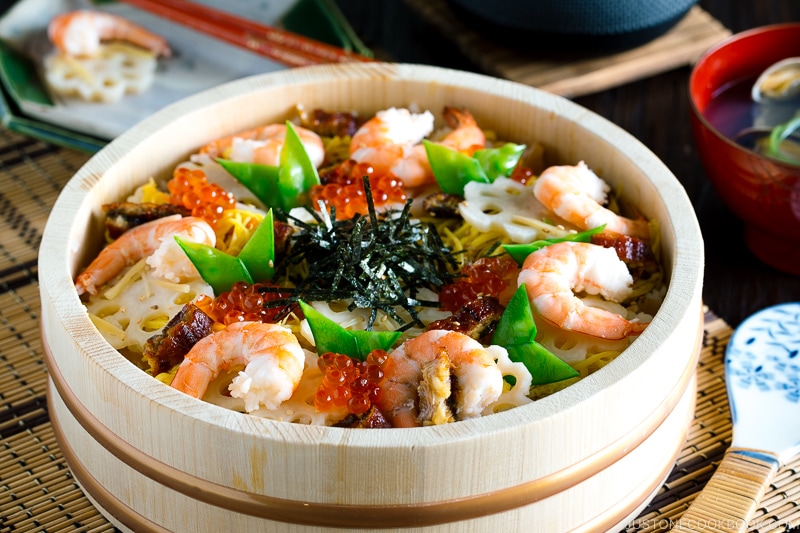
Ingredients and Topping Choices
Every family has their own version of chirashi sushi, and today I’ll show you how you can make it your own too!
In my recipe, I included some traditional ingredients which can be hard to find if you don’t live near a Japanese grocery store. However, you have the flexibility to simplify and modify! Feel free to leave out any ingredients you can’t find.
Here are my suggestions for ingredients and toppings that go well with chirashi sushi:
Ingredients (to mix in with the sushi rice):
- Dried shiitake mushrooms
- Carrots
- Gobo (burdock root) — can also be found at Whole Foods or local co-ops.
- Dried kanpyo (gourd strips)
- Bamboo shoot (blanched)
- Inari age (seasoned deep-fried tofu pouch)
- Kamaboko and chikuwa (fish cakes)
- Koyadofu (seasoned dehydrated tofu)
Toppings:
- Avocado (sliced or cubed)
- Snow peas
- Green beans (blanched)
- Egg crepe
- Shrimp
- Crab (real or imitation)
- Kinome (木の芽 (山椒)) – I look for it locally but no luck…
- Octopus (boiled)
- Sakura denbu (seasoned ground codfish) – pink color adds a nice touch for Girl’s Day celebration!
- Tobiko (flying fish roe)
Make Chirashi Sushi for Hinamatsuri & Potluck!
Traditionally, Chirashi Sushi is eaten on Hinamatsuri (雛祭り) or Doll’s Festival on March 3 every year. You can read more about this Japanese custom in this post.
Chirashi Sushi is a very easy type of sushi and does not involve any raw fish. It’s a perfect dish for big family gatherings and potluck parties!
You can purchase the sushi mixing bowl called hangiri (or sushi oke) on Amazon. My hangiri below is 10″ (26 cm) which is great for a family of four.

Quick & Easy Chirashi Sushi Recipes
1. Simplified Chirashi Sushi using a packaged seasoning mix — this is one of the easiest sushi recipes you can make at home!

2. Chirashi Sushi Cake – This is a modern take on chirashi sushi and very popular at weddings.

Wish to learn more about Japanese cooking? Sign up for our free newsletter to receive cooking tips & recipe updates! And stay in touch with me on Facebook, Pinterest, YouTube, and Instagram.

Chirashi Sushi
Ingredients
For the Pickled Lotus Root & Ginger
- 2 inches lotus root (renkon)
- 1 knob ginger (1 inch, 2.5 cm)
- ½ cup rice vinegar (unseasoned)
- ⅓ cup sugar
- ½ tsp Diamond Crystal kosher salt
For the Chirashi Sushi Mix
- 4 dried shiitake mushrooms
- ½ cup water (for soaking the shiitake)
- ⅔ gobo (burdock root)
- 0.8 oz dried kanpyo (gourd strips)
- 1 tsp Diamond Crystal kosher salt (for the kanpyo)
- ½ carrot
- 1¼ cups dashi (Japanese soup stock)
- ¼ cup sake (4 Tbsp)
- 3 Tbsp mirin
- 1 Tbsp sugar
- 2 Tbsp soy sauce
For the Egg Crepe (Kinshi Tamago)
- 3 large eggs (50 g each w/o shell)
- 1 Tbsp sugar (optional)
- 1 Tbsp dashi (Japanese soup stock) (or sake or water)
- ¼ tsp Diamond Crystal kosher salt
- ½ Tbsp neutral oil
For the Snow Peas
- 6 snow peas
- ⅛ tsp Diamond Crystal kosher salt
For the Sushi Rice
- 2¼ cups uncooked Japanese short-grain white rice (3 rice cooker cups, 540 ml; yields 6⅔ cups or 990 g of cooked rice)
- 2¼ cups water (540 ml)
- 1 piece kombu (dried kelp) (5 g; 2 x 2 inches, 5 x 5 cm per piece)
- ⅓ cup rice vinegar (unseasoned)
- 3 Tbsp sugar
- 1½ tsp Diamond Crystal kosher salt
For the Unagi (Eel)
- 1 fillet unagi (freshwater eel) fillet (5.6 oz, 160 g)
For the Shrimp
- 8–10 large and jumbo shrimp
- 1 Tbsp sake
- ⅛ tsp Diamond Crystal kosher salt
For the Toppings (optional)
- 4 Tbsp ikura (salmon roe)
- ½ Tbsp toasted white sesame seeds
- 4 Tbsp shredded nori seaweed (kizami nori)
Instructions
To Make the Pickled Lotus Root & Ginger
- Gather all the ingredients.
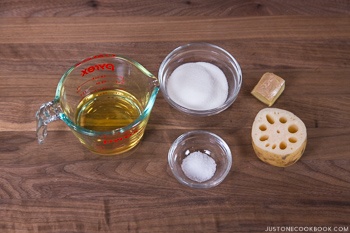
- Combine ½ cup rice vinegar (unseasoned), ⅓ cup sugar, and ½ tsp Diamond Crystal kosher salt in a small saucepan. Bring it to a boil and let the sugar dissolved completely. Set aside to cool.

- Peel and cut 1 knob ginger into thin julienned strips (the thinner, the better). Peel 2 inches lotus root (renkon) and cut out the edge to make a flower shape (read how in my hana renkon tutorial).

- Cut the lotus root into ⅛-inch (3-mm) slices. Soak them in vinegared water (add 1 tsp rice vinegar to a bowl of water) for 5 minutes to prevent it from turning brown.

- Boil some water in a small saucepan and blanch the ginger and lotus root for 3 minutes. Drain well and transfer them to the vinegar and sugar mixture to marinate. Make in advance: You can make this ahead of time and keep it up to 1 week in the refrigerator.

To Make the Chirashi Sushi Mix
- Gather all the ingredients.
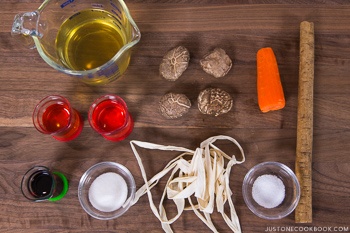
- Soak 4 dried shiitake mushrooms in ½ cup water until they are hydrated and tender. Then, squeeze the mushrooms and reserve the liquid (this is called shiitake dashi) in the bowl. Cut off and discard the stems.

- Slice the shiitake mushrooms. Strain the reserved shiitake dashi to remove any impurities. Save this shiitake dashi until you’re ready to use it in Step 8.

- Make a crisscross incision at one end of ⅔ gobo (burdock root). This incision will help you shave the gobo like a pencil. Shave it into small, thin pieces as you rotate the gobo. Soak the cut pieces in water so they won‘t turn brown. Change the water 1–2 times. Drain right before you start cooking in Step 8.
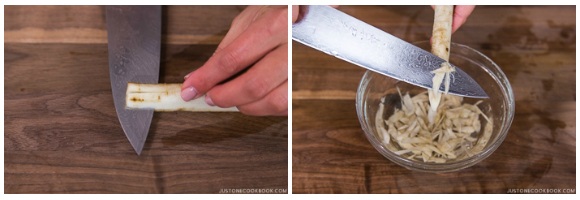
- In a small saucepan, bring some water to a boil. Quickly rinse 0.8 oz dried kanpyo (gourd strips) in running water and drain. Rub the kanpyo with 1 tsp Diamond Crystal kosher salt. Rinse and drain well.

- When the water is boiling, cook the kanpyo for 3 minutes. Transfer to iced water to stop the cooking process and squeeze the water out.

- Cut the kanpyo into small pieces. Next, cut ½ carrot into julienned strips.

- Add the shiitake mushrooms, gobo, and kanpyo to the empty pot (keep the carrot aside for now). Add 1¼ cups dashi (Japanese soup stock), the reserved shiitake dashi (the liquid from hydrating dried shiitake), ¼ cup sake, 3 Tbsp mirin, 1 Tbsp sugar, and 2 Tbsp soy sauce. Bring it to simmer on medium heat.

- Skim the foam and scum on the surface as much as you can, decrease the heat to a simmer, and cover with an otoshibuta (drop lid). This lid ensures that the ingredients are submerged under the liquid and the flavorful cooking liquid circulates well. To easily make one with aluminum foil, follow my tutorial.

- Add the carrot while there is still liquid in the pot but toward the end of cooking so that you don‘t overcook carrot (you don‘t want it mushy). Continue to cook with the otoshibuta until the liquid is almost gone. The whole cooking process is about 20–25 minutes, depending on the heat. Transfer the Chirashi Sushi Mix to a plate to cool completely. If you end up with some extra cooking liquid, you can save a little bit to season the rice later. Make in advance: You can make this ahead and keep it in the refrigerator for up to 3–4 days.

To Make the Egg Crepes
- Gather all the ingredients for the Kinshi Tamago.
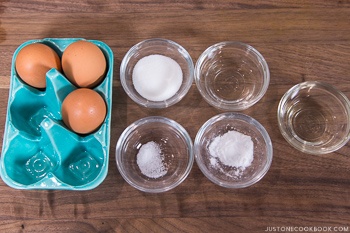
- Whisk 3 large eggs (50 g each w/o shell). Add the rest of the ingredients into the bowl: 1 Tbsp sugar, 1 Tbsp dashi (Japanese soup stock), and ¼ tsp Diamond Crystal kosher salt. Whisk to combine; then, strain the egg mixture to get a silky texture.

- Heat a large nonstick frying pan and grease the pan with a paper towel dipped in ½ Tbsp neutral oil. Make sure to wipe off the excess oil. When the pan is hot, pour just enough egg mixture to cover the bottom of the entire frying pan.

- Tilt the pan to fill the frying pan with the egg mixture and cover with the lid. Remove the pan from the heat and place it on a cold towel to cool so the egg doesn‘t become brown. Once the egg crepe is cooked through, transfer to a wire rack and let cool completely. Continue this process until all the egg mixture is gone.

- Roll up the egg crepes and cut thinly into julienned strips. Loosen them up and set aside. Make in advance: You can make this ahead and keep it in the refrigerator for up to 2–3 days or in the freezer for up to a month.

To Prepare the Snow Peas
- Remove the tough strings from the edges of 6 snow peas. Bring some water to boil in a small saucepan. Add ⅛ tsp Diamond Crystal kosher salt and blanch the snow peas for 2 minutes. Drain and cut diagonally in half or thirds.

To Cook the Sushi Rice
- Gather all the ingredients. For detailed, step-by-step instructions with photos, please see my post on How to Make Sushi Rice.

- Rinse and wash 2¼ cups uncooked Japanese short-grain white rice (3 rice cooker cups) 3 times and drain well.

- Put the rice in a rice cooker bowl and add 2¼ cups water, or up to the “sushi“ water level for 3 rice cooker cups (a bit less than regular rice). Place 1 piece kombu (dried kelp) on top. Soak the rice for 20–30 minutes. Then, start cooking. Tip: If you don‘t have a rice cooker, see how to cook short-grain rice using a pot over the stove, Instant Pot, or donabe.

- Meanwhile, prepare the sushi vinegar seasoning. In a bowl, combine ⅓ cup rice vinegar (unseasoned), 3 Tbsp sugar, and 1½ tsp Diamond Crystal kosher salt. Mix them together. You can microwave or heat the mixture in a saucepan over the stove to dissolve the sugar completely and remove the strong vinegar taste/smell. Set aside to add the sushi seasoning in a later step.

To Prepare the Unagi
- Unagi is typically already cooked/broiled when you purchase it. All you need to do is reheat in the oven. Set your oven to broil on High (550ºF/290ºC) and preheat for 3 minutes. Line the baking sheet with aluminum foil. Spray a bit of oil on the aluminum foil and place 1 fillet unagi (freshwater eel) fillet on top. Put the baking sheet in the middle rack of your oven and broil for 5–7 minutes (no need to flip). Once it’s cool to the touch, you can cut it into ¼-inch (0.6-mm) pieces. Set aside.
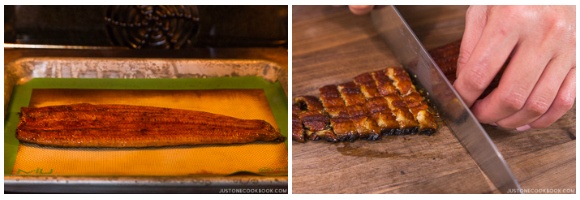
To Prepare the Shrimp
- Using a skewer, devein 8–10 large and jumbo shrimp without removing the shell (see my tutorial on how to devein shrimp). We peel the shell after cooking to retain the flavor of the shrimp. Boil water in a medium saucepan. Add ⅛ tsp Diamond Crystal kosher salt. Once boiling, add 1 Tbsp sake and the shrimp and simmer until pink, about 2–3 minutes. Remove the shell and set aside.

To Assemble the Chirashi Sushi
- Start this step when all the steps above are completed. When the rice is done cooking, discard the kombu from the cooked rice. Then, transfer the hot rice to a hangiri (sushi oke) (or a baking sheet lined with parchment paper). If you use a hangiri, quickly run it under water so the rice doesn’t stick.

- Pour the sushi vinegar seasoning over the rice paddle to evenly distribute the sushi vinegar over the rice.
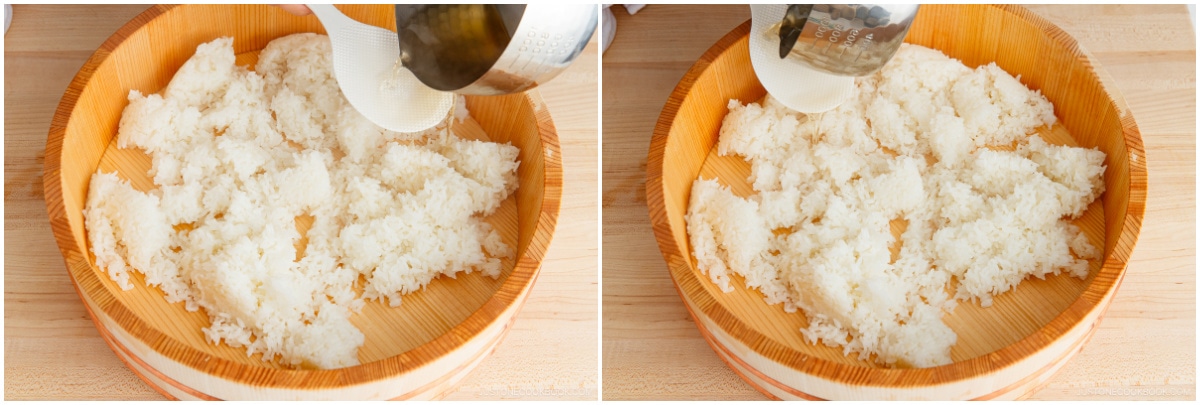
- With the rice paddle, slice the rice at a 45-degree angle to separate the rice and incorporate the seasoning (instead of mixing or stirring). At the same time, use a fan to cool the rice so the rice will shine and doesn‘t get mushy.

- Once the sushi rice is cooled, squeeze the Chirashi Sushi Mix to remove excess liquid (otherwise the rice gets too soggy). Add it to the sushi rice and gently combine with the rice paddle using a slicing motion. You can always add a few tablespoons of the reserved liquid to season the rice if you‘d like (I don‘t usually do it).

- Gather all the toppings you’ve prepared.

- First, scatter the shredded egg crepe on the sushi rice. Then, decorate the chirashi sushi as you like. I usually add the toppings in the following order: Lotus root, shrimp, unagi, snow peas, 4 Tbsp ikura (salmon roe), ½ Tbsp toasted white sesame seeds, and 4 Tbsp shredded nori seaweed (kizami nori) in the center. Enjoy!

To Store
- You can keep the leftovers in an airtight container and store in the refrigerator for 3 days and in the freezer for a month.








Nami, Love your website and recipes.
I’m about to make the chirashi but am wondering if this is right…for the chirashi rice – is 540 ml enough water for 3 cups of uncooked rice? 540 ml is a little over 2 c. of water!
Hi Joyce! Remember this is a RICE COOKER cup (180 ml, not 240 ml US cup). Please refer to my Sushi Rice recipe. 🙂
https://www.justonecookbook.com/how-to-make-sushi-rice/
Hello, Joyce! Thank you so much for taking the time to read Nami’s post and try her recipe!
Yes! Sushi rice is made with 540 ml of water.
When preparing uncooked rice, please make sure to use a rice cooker cup (180 ml/cup). It is smaller than a standard measuring cup.
We hope this helps!
Fantastic recipe! Very delicious with all the different flavors. This is my second time making this recipe for my family for Hinamatsuri, my family was impressed, especially my Japanese immigrant parents 🙂 Thank you Nami-san for making this recipe available in English!!
Hi Ayako! We are so happy to hear Nami’s tutorial was helpful and that the dish brought so much excitement to your family!
Thank you very much for trying the Nami recipe and for your kind feedback.
Happy Cooking!
Kinome are the leaves of the Japanese pepper tree, Zanthoxylum piperitum. This is the same tree that produces kona zanshō.
Hi Steve! Thank you very much for your input!
Wonder what other type of vegetables can you add to this?
Hi Dennis, It can be very creative and add green leaves vegetables like Spinach, Edamame, Broccoli, Broccolini, Mitsuba, Shiso leaves, etc. We hope this helps!
Looks delicious and very involved. Can I come and taste yours? I’ll bring my spoon!
Hi Lili! Hahahaha! Thank you for your kind words!
You inspired our dinner tonight! My daughter got me two tubs of lovely organic miso for Christmas, and I had planned on making Baked Miso Chicken but I was at a loss for what should go with it. I didn’t want just plain rice and then I stumbled across this Chirashi recipe. I always have the sashimi style when I go out for sushi so the vegetable style was an utter revelation! Alas, we live in South Texas and Asian ingredients are often scarce. I was stuck with what I had on hand: I spiralized a zucchini, cut the zoodles in 2″ lengths, julienned some baby carrots , minced some mushrooms, employed some chicken stock, sake, soy sauce and a bit of sugar and shredded green onion. Followed your directions on how to “cut” it into the rice, I actually had a nice bamboo rice paddle, and had chirashi inspired rice that was wonderfully delicious and perfectly complimented the miso baked chicken thighs. A little of the reserved unused miso marinade drizzeled over the top with some shredded seaweed and black and white sesame seeds made for a dinner my wife declared one of my most delicious dishes yet! I am enamored of this cookbook and I will continue to draw inspiration and direction for many, many more wonderful meals!
Hi Michael! Wow, I truly enjoyed reading your cooking adventure and thank you for sharing the story with me! I can tell you’re a wonderful cook by how you managed to use substitutes and make a beautiful dish. Your wife is so lucky! 🙂 I hope you find some inspiration from my blog. Thank you for your kind feedback!
Nami san
Thanks for sharing another great recipe! You have a photo above where you cut up what looks like cucumber into a shape of a bowl. Do you think you could do a short video showing how that is done? It really makes this rice dish really pretty.
Hi Francis! Are you talking about the chirashi sushi cake? I’m not sure if we will make a video for this recipe, but I have a step by step instruction here: https://www.justonecookbook.com/chirashi-sushi-cake-and-temari-sushi-and-giveaway-winners/
Hope that his helpful. 🙂
Nami
Hi Nami san
Ok thanks, I will check out the recipe from the link!
This looks wonderful!! I am wondering how best to store this after assembled if not eating right away (i.e. make in the morning to eat for lunch later in the day)? Should this be kept in the fridge or will the rice dry out? Thank you!
Hi Lauren! Thank you!! The rice may become hard but, my trick is to cover the dish (rice) with thick towel so the dish doesn’t get too cold but stay cool enough. Cold air makes the rice hard so try protecting it from getting too cold. 🙂 Hope this trick helps. I use this trick for leftover sushi rolls and chirashi sushi etc. 🙂
I’m so happy I found your recipe! I have been using the Taro Sushi brand sushi rice mix for years and stuffing it into my inari. One of my favorite things that my host mom introduced to me while I studied in Japan. However I went to buy a package at the store today and found a warning label placed on the package:
“WARNING: Consuming this product can expose you to chemicals including lead, arsenic, and cadmium which is are known to the State of California to cause cancer and birth defects or other reproductive harm. For more information go to http://www.P65Warnings.ca.gov/food”
Obviously this concerned me and deterred me from buying it. I have no idea how serious that label is, cuz if it was so serious they wouldn’t be selling it, right? If you know anything about that I’d appreciate some input.
Regardless I can’t imagine a life without the chirashi rice in my inari so thank you again for posting this! I’ll be making it soon. 🙂
Hi Eilene! I believe most of the seaweed products get that “warning” sign. I can’t explain well, but you should look into articles on it. My understanding is that under the law they have to put the label because of one case. But it’s not something that we have to worry. You have to eat an unreasonable amount of seaweed PER DAY to start worrying about it. And Japanese people in Japan eat way more seaweed in their daily life than any of us in a week… and their consumption is not even at the level that they should be worried. But you should research yourself to make sure. 🙂
However, it’s good to eat homemade chirashi than packaged one. I’d be more worried about preservatives in the package than the seaweed. It’s very convenient and I think it’s totally okay to eat once in a while. I rely on some packaged stuff for convenience too. 🙂 Hope you enjoy the recipe!
Thanks for the info! I made your recipe last night and was so excited how similar it tasted to the package. It was a hit. Thanks again!
Hi Eilene! I’m happy to hear that. Thank you so much for your kind feedback! 🙂
Wonderful post! 😀 Please share with me the name of the flower/petal shaped white topping.
Thank you 😀
Hi Maya! That’s lotus root. 🙂
Hi Raymund! I’m so happy to hear you had a wonderful trip to Japan and enjoy meals there. 🙂 Oh I can imagine the meal in Tsukiji must be a good one to remember! 🙂
Chirashi Sushi is one of my favorites – especially when it has uni and ikura. I have eaten Bara Sushi once – it took me by surprise! But it was very tasty 🙂
Hi Rachael! So you know this dish by “Bara Sushi” too! Maybe you tried in Osaka area? I grew up knowing this dish Bara Sushi. Happy to know you like chirashi. 🙂
I actually ate “Bara Sushi” in Los Angeles! It was at a very nice restaurant. However, I will be traveling to Osaka (and Kyoto, Koyasan, Kinosaki and Tokyo) in May! I am very excited 😀
Hi Rachael! I can already see the restaurant is pretty authentic. I haven’t seen Bara Sushi on menu in Japanese restaurants I visited in the US! Have fun traveling in Japan in May. That’s a nice weather to travel (not hot, not cool, always sunny). 🙂
This looks very delicious.
I wonder how it actually is served. You place the plate on the table and the diners each take from the toppings and ladle rice in their bowls?
Hi Susanne! Yes, we usually serve to individual small plates, like a cake so that one person won’t take all the toppings. 🙂
Cherrypicking amongst the toppings was exactly what I suspected. Will prepare individual plates. Thanks
I’ll admit I was a bit confused at this post because the chirashi sushi you make in the recipe is the only one I’ve ever had/made! I guess it’s obvious I don’t go to sushi restaurants. LOL. Yours is much prettier than mine though and I wish my lotus root would look as nice! Where did you get your metal otoshibuta? I use parchment paper a lot when my wood doesn’t fit. Also just wanted to let you know that some of the ingredients and other links in this article have lines going through them so it looks like they’re crossed out?
Hi Salena! Haha yeah, if you go to Japanese restaurants here in the US, they usually have Chirashi Sushi on the menu. Also if you go to sushi restaurants in Japan, they have “chirashi sushi” too. In Tokyo area, I believe it mostly says Chirashi or Chirashi Sushi…. BUT some other parts of Japan probably say Kaisen Chirashi etc. I have to pay more attention to this myself when I go back to Japan this summer. It’s normal thing that I don’t usually pay attention to…
Otoshibuta – I looked around on Amazon but they don’t have it. I gave up and bought one when I was in Japan. It’s the best tool… It has nice weight to hold down the food.
Thanks for the heads up on the strikethrough links (usually it means dead links). I noticed some on different posts last night and I asked my developer checked on this. It was a strange problem but we got it fixed. Thank you!